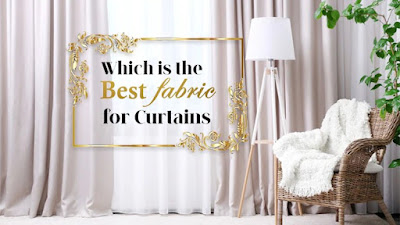While moving into another home, or rearranging your ongoing one, it tends to be an intriguing open door to pick new furnishings, floor coverings, and upholstery textures that make a living space that is a delight to be in.
Putting resources into new enhancements is an opportunity to imagine or reexamine your home to make something that suits you and your loved ones. It can permit you to layout a seriously loosening up climate or a really elevating one, or can be custom-made to satisfy the needs of a developing family or another pet.
New shades are one home outfitting that can totally adjust the vibe of the room. Besides the fact that they fill a reasonable need, however, they can act as a type of 'divider craftsmanship', highlighting specific regions of your home. With the developing moderateness of creator drapery textures, buying shades of a greater can is certainly worth the speculation.
Prior to picking your drape style and variety from a determination of architect shade textures, it is basic to take a gander at the sort of material that is generally fitting. The texture is much of the time ignored for style, which can prompt lament in the wake of having made the buy. This is basically in light of the fact that different drape textures are fit to various purposes in various homes.
Planner drapery textures can arrive in a scope of various 'loads', meaning they can be produced using extremely weighty to exceptionally light material. Specialists say that care ought to be taken to stay away from the two limits, in spite of the fact that purchasers can pick something lighter or heavier relying upon their requirements.
Heavier textures will more often than not hang better because of their stiffer nature, meaning they keep up with their shape when moved or pulled back around a window. In any case, exceptionally weighty textures may not crease well when moved back, which could conceivably be a look that you need in your home.
Then again, lighter textures may not fall as well as heavier ones; they might erupt out and oppose hanging in a uniform manner. Lighter planner drape textures do, notwithstanding, will generally overlap better, so this is something to remember.
Experts in fashioner drapery textures say that the best materials for finding some kind of harmony between the great characteristics of weighty and light materials are silk, fake silk, velvet, and cloth. Purchasers are in this way urged to think about these choices while settling on their choice.
While picking shades for your home, another thought is whether you would like your decision of texture to keep out the cold and square light from going into your home. These could be valuable on the off chance that you live in a space where there is a ton of fake light around evening time, keeping you from getting a decent night's rest, or on the other hand assuming the windows in your home permit a ton of cold air enter from outside.
Specialists express that there are various materials to use for protection purposes; these are generally utilized by famous inn networks, therefore. Assuming you have these worries, take a gander at purchasing velvet, calfskin, tweed, or woven artwork architect shade textures.
At last, thought necessities to given to whether you anticipate keeping your draperies around for quite a while or not. The justification for this is that some drape textures will blur more rapidly than others in the daylight. Picking unbiased tones can assist with keeping away from this issue as blur will be less noticeable. In any case, silk drapery material is bound to weaken in daylight than different textures.
All in all, there are various elements to consider while choosing from the huge number of planner drapery textures that are available. These incorporate the heaviness of the texture, its protecting characteristics, its protection from daylight, and solidness.
Assuming this large number of regions are painstakingly thought of, because of the colossal determination of textures accessible from retailers, it is ensured that you will track down the best one for the enrichment or redesign of your home.
Ice Fabrics is an expert retailer situated in the United Kingdom. Their internet-based store brags a colossal determination architect shade and upholstery textures, with a wide range of varieties, examples, and styles accessible for each taste. Ice Fabrics additionally offer various accomplices to supplement each texture buy, making it an all-inclusive resource for every one of their clients' upholstery and shade necessities. To guarantee that their clients generally settle on the ideal decision while buying from their web-based shop, Ice Fabrics liberally permits every one of their clients various 6 examples of texture. Esteeming the nature of both their items and the client experience, IceFabrics attempts to convey their best reliably.

Comments
Post a Comment